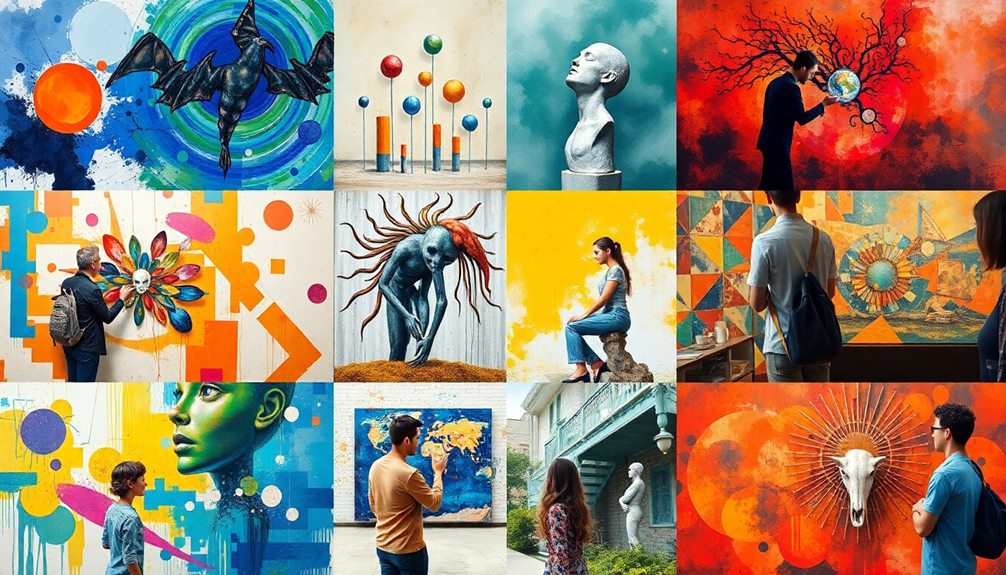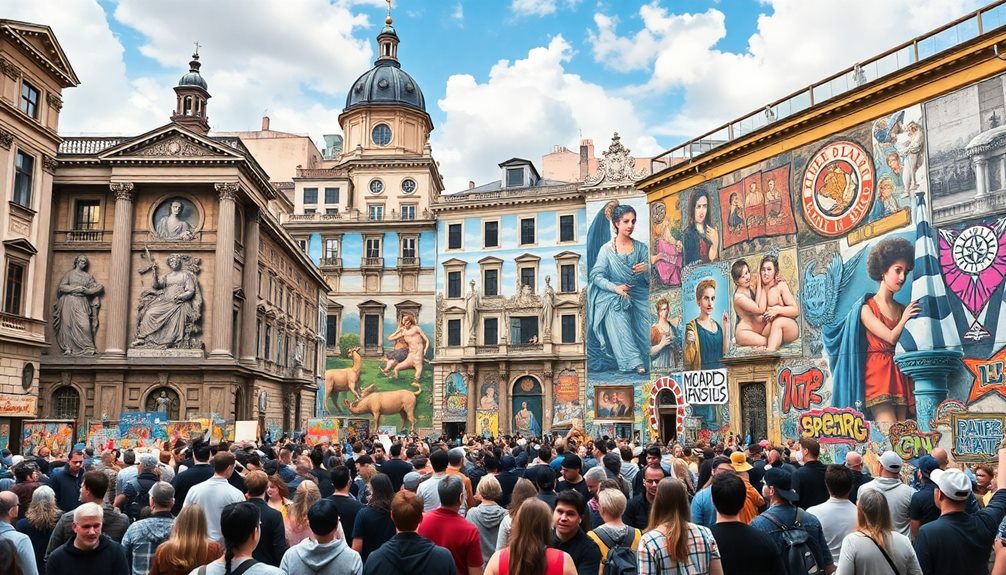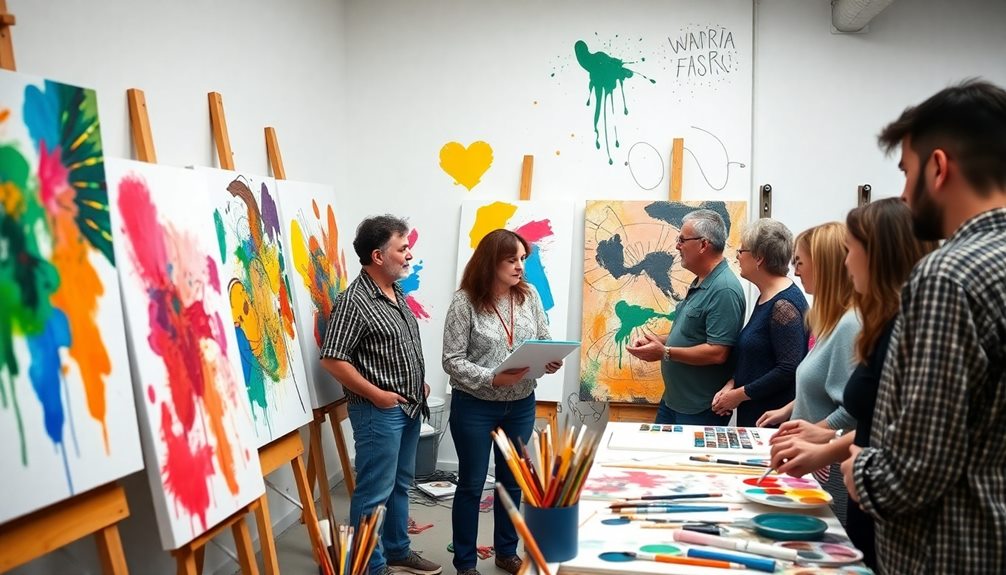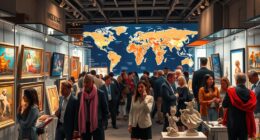Cross-curricular art education ideas can really boost student engagement. You can integrate art with history by using visual storytelling to explore cultural and political contexts. Incorporating science through nature journaling makes observations creative and fun. Tie math concepts to art with projects that emphasize symmetry or geometric shapes. Enhance language arts by encouraging character sketches or visual representations of themes. Community art projects foster connections while embracing cultural diversity. Technology also opens new doors, allowing students to experiment with digital tools. If you explore further, you'll find even more inspiring ways to connect art with various subjects.
Key Takeaways
- Integrate art with history by using visual storytelling to explore cultural and political contexts of different eras.
- Combine art and science through nature journaling, fostering observational skills and artistic expression simultaneously.
- Use art to teach mathematical concepts like symmetry and patterns through projects such as geometric string art and origami.
- Enhance language arts by creating character sketches and visual representations of literary themes to deepen understanding and engagement.
- Engage communities with public art installations and collaborative workshops that foster creativity and strengthen neighborhood connections.
Art in History and Geography

Art in history and geography offers a unique lens through which you can explore the past and understand different cultures. By examining art as a historical document, you uncover the cultural, social, and political contexts of specific eras. This approach enhances your understanding of historical events and the societies that shaped them.
Incorporating geography into art education makes the learning experience even richer. You could create maps or flags representing studied countries, helping you visualize and connect with the geographical concepts being taught. Dedicated art journal pages with dates and lesson titles allow you to document your learning journey, fostering a deeper connection between art and historical knowledge.
Visual storytelling through art brings history to life, depicting significant figures and events in a way that's engaging and relatable. By exploring cultural art forms from various historical contexts, you not only enrich your appreciation of diversity but also gain insights into the values and beliefs of different societies.
This cross-curricular approach to art education deepens your understanding of both history and geography, making the learning experience more impactful and enjoyable.
Art and Science Integration

Integrating art with science opens up a world of creativity and discovery, allowing you to explore complex concepts in an engaging way. One effective method is through nature journaling, where you can document your scientific observations while blending artistic expression.
Simple art projects like leaf rubbings or outdoor sketching enhance your understanding of natural phenomena and ecosystems, making the learning experience more tangible.
You might also enjoy painting the solar system, which offers a hands-on approach to astronomy. By visualizing planets and their orbits, you can grasp the vastness of space in a fun, interactive manner.
Meanwhile, incorporating clay or recycled materials into your lessons allows you to create animal sculptures. This kinesthetic learning reinforces biology concepts, making them easier to remember.
In mixed media courses, you can experiment with different artistic techniques while studying environmental science, fostering a deeper appreciation for nature's complexities.
Incorporating Art Into Math

Bringing together art and math can transform how students grasp complex concepts. By integrating art lessons into math education, you allow students to visualize ideas like symmetry, patterns, and geometric shapes, making them more tangible. Projects like geometric string art and murals based on the Golden Ratio reinforce these mathematical principles while sparking creativity.
Engaging students in origami challenges not only teaches geometric folds but also enhances their problem-solving abilities in a fun way. Resources like Karyn Tripps' "Math Art and Drawing Games for Kids" provide structured activities that blend artistic expression with math learning seamlessly.
Here's a quick overview of some engaging activities:
| Activity | Benefits |
|---|---|
| Geometric String Art | Visualizes geometric shapes |
| Fibonacci Art | Enhances critical thinking |
| Origami Challenges | Improves spatial reasoning |
Cross-curricular projects, such as Fibonacci art, boost engagement and promote collaboration among students as they explore math concepts through creative mediums. By incorporating art into your math curriculum, you create a dynamic learning environment that nurtures both creativity and analytical skills.
Enhancing Language Arts With Art
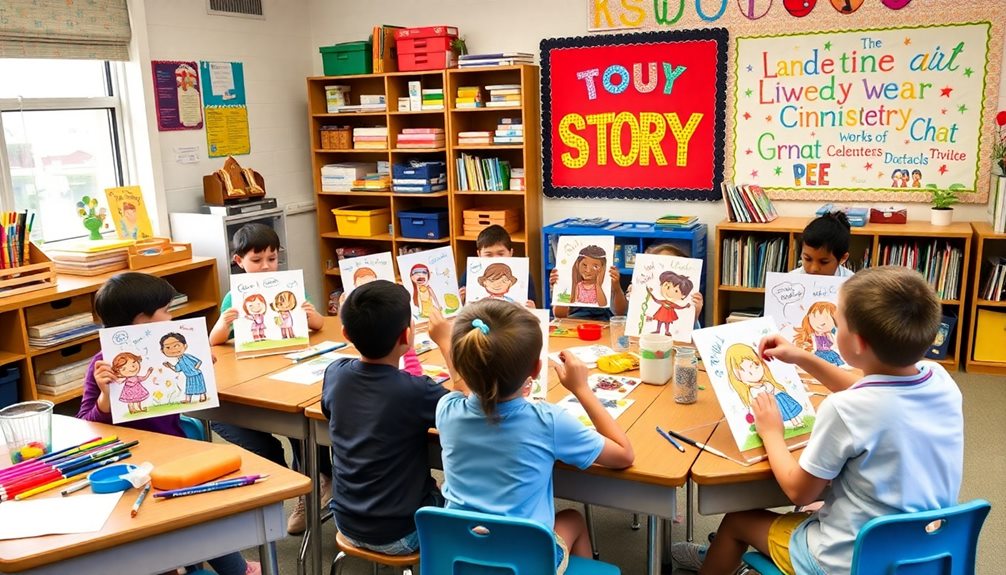
Incorporating visual arts into language arts can considerably elevate students' engagement and understanding. By integrating art projects like character sketches or visual representations of scenes, you allow students to express their interpretations creatively. This creative expression not only boosts their enthusiasm but also deepens their comprehension of the material.
Moreover, incorporating strategies for improvement, such as setting clear goals for artistic projects, can enhance students' focus and dedication to their learning process nurturing resilience and learning.
Engage your students with innovative methods, such as painting words or creating comic strips, to reinforce spelling and grammar concepts. These dynamic activities make learning more enjoyable and memorable.
During read-aloud sessions, encourage students to visualize characters and settings through art activities, fostering a greater understanding of literary themes and nurturing retention.
Consider organizing events like a Poetry Palooza Chalk Party, where poetry meets visual art. This combination motivates students to explore different literary forms while expressing themselves creatively.
Additionally, integrating visual arts into your language arts lessons strengthens students' listening skills as they reflect on and respond to artistic representations of literary elements.
Incorporating these strategies not only enhances engagement but also transforms the language arts experience into a vibrant exploration of ideas, enriching students' learning journey in a unique and impactful way.
Community Engagement Through Art

Bringing art into your community through public installations can truly transform local spaces and spark pride among residents.
By organizing community art workshops, you not only foster creativity but also strengthen connections between neighbors.
These collaborative efforts can create a vibrant atmosphere that reflects the unique spirit of your area.
Public Art Installations
Public art installations transform urban spaces into vibrant community hubs, fostering pride and shared cultural experiences among residents and visitors.
They serve as a bridge, connecting diverse groups through art, while also supporting local artists and the creative economy. When you engage your community in these projects, you create an atmosphere of inclusivity and collaboration.
Here are three key benefits of public art installations:
- Community Engagement: Involving residents in the participatory design process helps them contribute ideas, ensuring the artwork reflects their identity and values. This leads to a deeper connection and sense of ownership over the space.
- Boosting Local Economies: Research shows that public art can increase foot traffic in neighborhoods. When people come to see the installations, they're likely to visit local businesses, enhancing the community's economic significance.
- Cultural Experiences: These installations provide an opportunity for shared cultural experiences, allowing individuals to engage with art in meaningful ways. By showcasing diverse perspectives, public art can strengthen social cohesion and celebrate the community's rich heritage.
Embrace public art installations to enrich your community and inspire connections!
Community Art Workshops
Art can serve as a powerful tool for community engagement, and community art workshops are a perfect example of this. These workshops create a platform for local artists and residents to collaborate, fostering a sense of belonging and cultural exchange.
By focusing on specific themes—like environmental awareness or cultural heritage—you'll see participants express their ideas and values through creative expression. Additionally, these workshops can incorporate innovative problem-solving skills, encouraging participants to think critically and adapt their artistic visions to collaborative projects.
Engaging community members in art-making promotes social cohesion, reducing isolation while enhancing overall mental well-being. You'll find that these workshops often incorporate education, teaching valuable artistic techniques and art history, which empowers participants with new skills.
Successful community art projects, such as murals or public installations, can beautify local spaces, creating a lasting impact that encourages pride and ownership among residents.
When you get involved in community art workshops, you not only contribute to the aesthetic of your neighborhood but also help build connections and strengthen community ties. Through these initiatives, you can witness firsthand how art transforms lives and communities, making it an invaluable part of fostering a vibrant, engaged society.
Technology and Digital Art
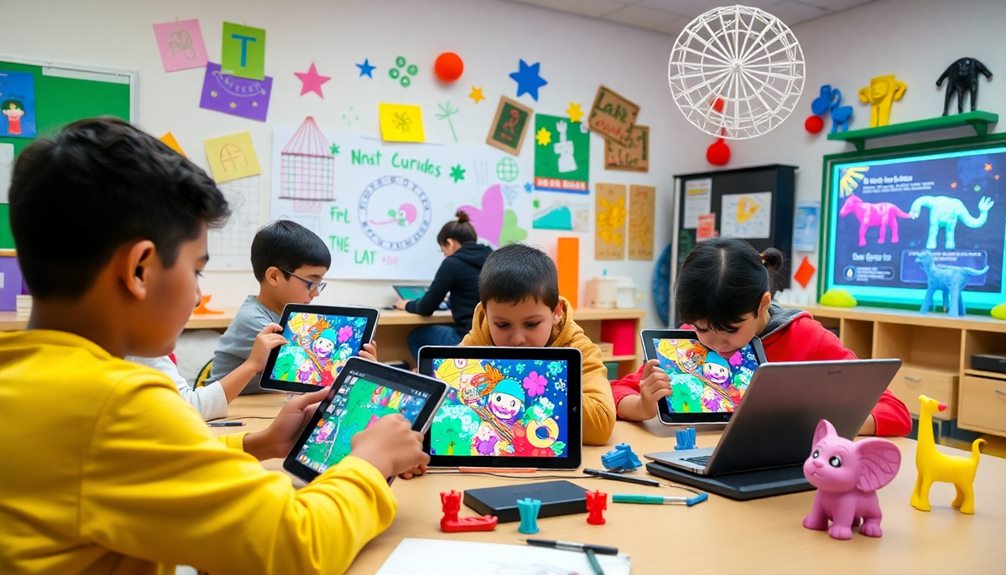
In today's digital age, students can harness a variety of technology tools to enhance their artistic skills and creativity. Digital art not only broadens their horizons but also merges traditional techniques with modern innovations.
Furthermore, integrating tools like Natural Language Processing (NLP) can further personalize the learning experience, allowing students to receive tailored feedback and support.
Here are three ways technology can elevate art education:
- Graphic Design Software: Students can use various apps to create stunning pieces that reflect their unique styles. These tools allow for experimentation and refinement, essential for developing their artistic voice.
- Interactive Art Installations: By learning coding, students can create installations that engage viewers in new ways. This fusion of programming and visual creativity makes art more dynamic and accessible.
- Virtual Reality: Immersing students in 3D environments can revolutionize how they experience and create art. Virtual reality opens up innovative avenues for exploration and expression.
Additionally, platforms like online galleries let students showcase their work, fostering a sense of community and encouraging peer feedback.
Including lessons on the evolution of technology in art helps students appreciate how these tools have shaped contemporary practices. Embracing technology in art education cultivates well-rounded, tech-savvy artists ready for the future.
Cultural Arts Exploration

Exploring cultural arts opens a window to the rich tapestry of traditions and histories that shape our world. By studying traditional art forms, you gain a deeper appreciation for cultural diversity and the historical contexts behind artistic expressions. Engaging in projects that celebrate this diversity allows you to create visual representations of global festivals, traditional crafts, and indigenous designs.
Hosting cultural exchange events is a fantastic way to learn from individuals with various backgrounds. These events promote inclusivity and collaboration, enhancing your understanding of different heritages. You might consider collaborating with cultural organizations to provide hands-on experiences, offering insights into traditional techniques and their significance.
Additionally, exploring the influence of cultural heritage on contemporary art illustrates how past traditions inspire artistic innovation today. Here's a quick look at some activities you can engage in:
| Activity | Description |
|---|---|
| Visual Art Projects | Create artworks inspired by global traditions. |
| Cultural Exchange Events | Host performances showcasing diverse cultures. |
| Workshops with Artists | Learn traditional techniques from experts. |
| Contemporary Art Analysis | Discuss how culture influences modern art. |
Dive into cultural arts exploration, and let it enrich your artistic journey!
Frequently Asked Questions
What Is an Example of Cross Curricular Learning?
An example of cross-curricular learning is when you study a historical event in social studies and then write a poem about it in language arts. This approach deepens your understanding by connecting different subjects meaningfully.
How Do We Integrate Art to Other Curricular Areas?
Imagine transforming your classroom into a vibrant gallery! You can integrate art by blending visual projects with subjects like history, science, and math, making learning dynamic and memorable while enhancing students' creativity and understanding.
What Are Cross-Curricular Topics?
Cross-curricular topics blend various subjects, allowing you to explore connections between disciplines. For instance, you might study history through art or analyze literature's themes visually, enhancing your understanding and fostering creativity across learning areas.
How Can I Make My Art Class Interesting?
To make your art class interesting, incorporate hands-on projects, use technology creatively, engage students with interactive activities, encourage collaboration, and host themed events. These approaches foster excitement and enhance learning through artistic exploration.
Conclusion
As you weave art into various subjects, think of a vibrant tapestry, where each thread represents a unique discipline, intertwining to create a stunning whole. By blending colors of history, science, and language, you're not just teaching but igniting creativity in your students. Let their imaginations soar like kites in a clear blue sky, connecting cultures and ideas, while technology serves as the wind beneath those wings. Embrace this journey, and watch them flourish.

